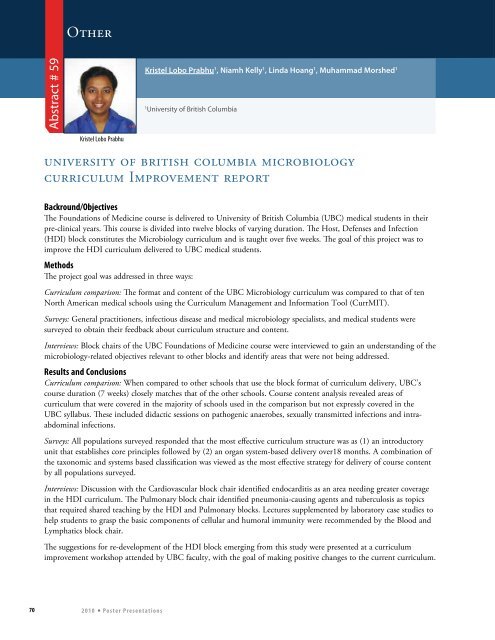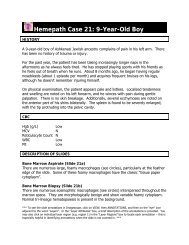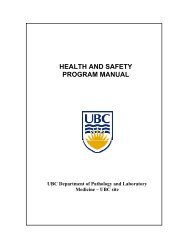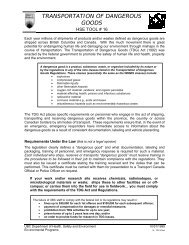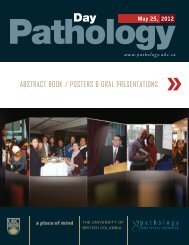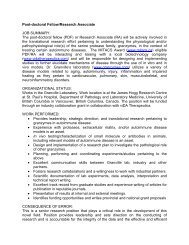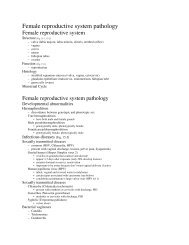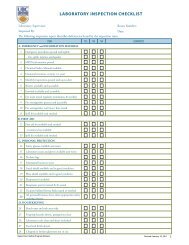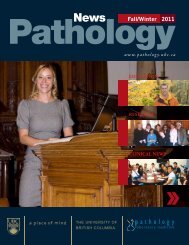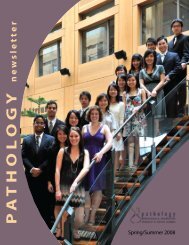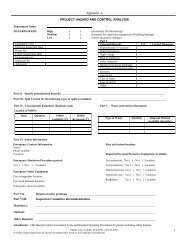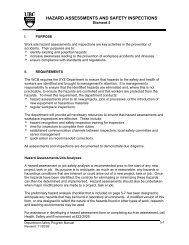Oral Presentations - Pathology and Laboratory Medicine - University ...
Oral Presentations - Pathology and Laboratory Medicine - University ...
Oral Presentations - Pathology and Laboratory Medicine - University ...
Create successful ePaper yourself
Turn your PDF publications into a flip-book with our unique Google optimized e-Paper software.
OtherAbstract # 59Kristel Lobo Prabhu 1 , Niamh Kelly 1 , Linda Hoang 1 , Muhammad Morshed 11<strong>University</strong> of British ColumbiaKristel Lobo Prabhuuniversity of british columbia microbiologycurriculum Improvement reportBackround/ObjectivesThe Foundations of <strong>Medicine</strong> course is delivered to <strong>University</strong> of British Columbia (UBC) medical students in theirpre-clinical years. This course is divided into twelve blocks of varying duration. The Host, Defenses <strong>and</strong> Infection(HDI) block constitutes the Microbiology curriculum <strong>and</strong> is taught over five weeks. The goal of this project was toimprove the HDI curriculum delivered to UBC medical students.MethodsThe project goal was addressed in three ways:Curriculum comparison: The format <strong>and</strong> content of the UBC Microbiology curriculum was compared to that of tenNorth American medical schools using the Curriculum Management <strong>and</strong> Information Tool (CurrMIT).Surveys: General practitioners, infectious disease <strong>and</strong> medical microbiology specialists, <strong>and</strong> medical students weresurveyed to obtain their feedback about curriculum structure <strong>and</strong> content.Interviews: Block chairs of the UBC Foundations of <strong>Medicine</strong> course were interviewed to gain an underst<strong>and</strong>ing of themicrobiology-related objectives relevant to other blocks <strong>and</strong> identify areas that were not being addressed.Results <strong>and</strong> ConclusionsCurriculum comparison: When compared to other schools that use the block format of curriculum delivery, UBC’scourse duration (7 weeks) closely matches that of the other schools. Course content analysis revealed areas ofcurriculum that were covered in the majority of schools used in the comparison but not expressly covered in theUBC syllabus. These included didactic sessions on pathogenic anaerobes, sexually transmitted infections <strong>and</strong> intraabdominalinfections.Surveys: All populations surveyed responded that the most effective curriculum structure was as (1) an introductoryunit that establishes core principles followed by (2) an organ system-based delivery over18 months. A combination ofthe taxonomic <strong>and</strong> systems based classification was viewed as the most effective strategy for delivery of course contentby all populations surveyed.Interviews: Discussion with the Cardiovascular block chair identified endocarditis as an area needing greater coveragein the HDI curriculum. The Pulmonary block chair identified pneumonia-causing agents <strong>and</strong> tuberculosis as topicsthat required shared teaching by the HDI <strong>and</strong> Pulmonary blocks. Lectures supplemented by laboratory case studies tohelp students to grasp the basic components of cellular <strong>and</strong> humoral immunity were recommended by the Blood <strong>and</strong>Lymphatics block chair.The suggestions for re-development of the HDI block emerging from this study were presented at a curriculumimprovement workshop attended by UBC faculty, with the goal of making positive changes to the current curriculum.70 2 0 1 0 * P o s t e r P r e s e n t a t i o n s


